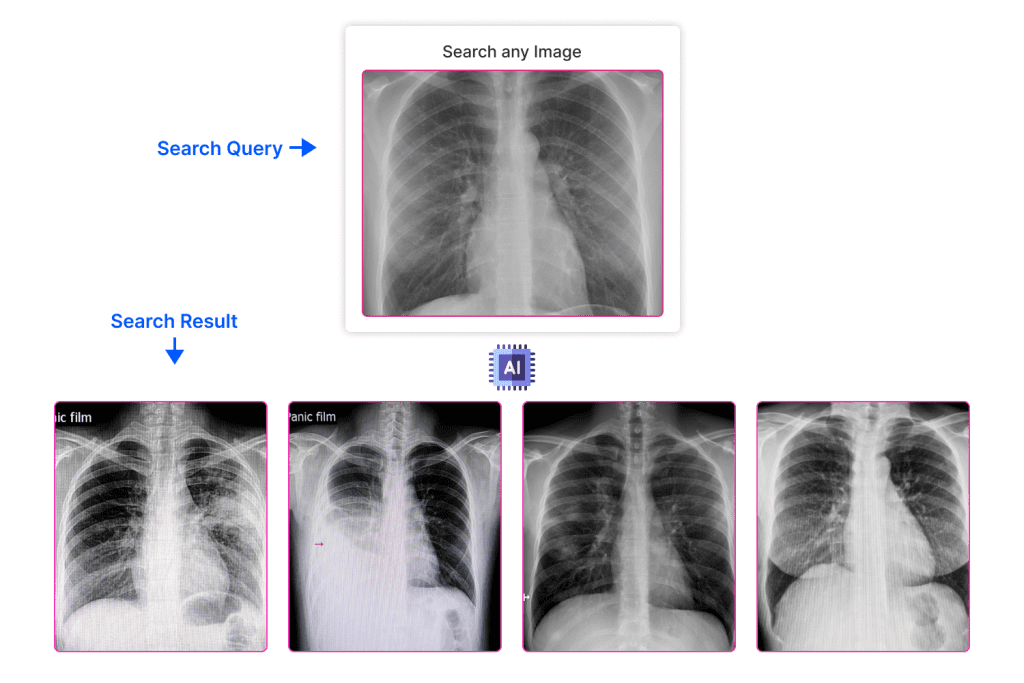
adminMarch 8, 2023Uncategorized
Image similarity technology is an AI-based technology that helps to compare and analyze images based on their visual content. In today’s world, businesses deal with a large amount of data, including images and videos. This has led to the need for image similarity technology that helps businesses manage their data more efficiently. Image similarity technology has many benefits for businesses. One of the main benefits is that it helps businesses to save time and resources. In this blog post, we will discuss the benefits and applications of image similarity technology in business.
What Is Computer Vision Image Similarity?
A computer vision application that compares images to identify their similarity based on their visual characteristics is called image similarity. The goal of image similarity is to quantify the degree of similarity between two images using numerical metrics.
There are many methods for computing image similarity, ranging from simple metrics such as mean squared error and correlation coefficient to more complex algorithms such as feature extraction and machine learning techniques. These methods are used to compare various aspects of the images, such as color, texture, and shape, to determine their similarity. The choice of method depends on the specific application and the characteristics of the images being compared.
The main applications of the image similarity technique include image retrieval, object recognition, and face recognition. Image similarity, for example, is used in image retrieval to find images similar to a query image. Image similarity can be used in object recognition to match a given object with a known database. An image similarity algorithm is used to identify people by comparing their faces to a database.
How Does Image Similarity Work?
There are various techniques for computing image similarity, but they typically involve the following steps:
1. Feature extraction
In this step, we extract relevant features from the images, such as color, texture, and shape. This is done using various techniques such as edge detection, histogram analysis, and convolutional neural networks (CNNs).
2. Feature comparison
Once the features are extracted, they are compared to determine the similarity between the images. This can be done using various distance or similarity metrics such as Euclidean distance, cosine similarity, or correlation coefficient.
3. Thresholding
Finally, a threshold is applied to the similarity score to determine whether the images are considered similar or dissimilar. The threshold depends on the specific application and is chosen based on a trade-off between precision and recall.
For example, in a simple scenario, the mean squared error (MSE) can be used as a metric for image similarity. The MSE is the average of the squared differences between the pixel values of the two images. The lower the MSE, the more similar the images are. If the MSE is below a certain threshold, the images are considered to be similar.
Advanced techniques, such as CNNs or deep learning algorithms, are used in more complex scenarios, such as object recognition or face recognition. Image similarity can be enhanced by using these techniques to extract more complex and abstract features from images.
Image Similarity Algorithms: what are some of them?
There are various measures that can be used to determine the similarity between two images. Some of the most commonly used algorithmic techniques are discussed below:
Mean Squared Error (MSE)
MSE is a measure of the average squared difference between two images. It compares the intensity values of corresponding pixels in two images. The lower the value of MSE, the more similar the images.
Structural Similarity Index (SSIM)
SSIM is a measure of the similarity between two images, which takes into account various factors such as luminance, contrast, and structure. It produces a score between -1 and 1, where 1 indicates identical images.
Cosine Similarity
Cosine similarity is a measure of the similarity between two vectors. In the context of image similarity, it works by converting each image into a vector and then computing the cosine similarity between the vectors. The higher the cosine similarity, the more similar the images.
Histogram Comparison
Histogram comparison works by comparing the color distribution of two images. It computes a histogram for each image, which represents the frequency of occurrence of each color. Then, it compares the histograms using various distance metrics such as Euclidean distance or chi-square distance.
Convolutional Neural Networks (CNNs)
CNNs have shown great success in image similarity tasks. They work by extracting features from the images and then comparing these features. The most common method is to use a pre-trained CNN to extract features from the images, and then use these features for similarity comparison.
What are the Most Interesting Applications of Image Similarity?
Image similarity has several interesting applications in the field of computer vision and image processing. The following are some of the most notable applications:
Reverse Image Search
Reverse image search is a technology that enables users to search for similar or identical images based on a query image. It is useful for identifying the source of an image, finding images with similar features, and discovering visually similar products or items.
Content-Based Image Retrieval (CBIR)
Content-based image retrieval (CBIR) is a technique for retrieving images from a database based on their visual features. CBIR has applications in image search engines, medical imaging, and e-commerce.
Image Clustering
Image clustering is a technique that groups similar images together based on their visual features. It is useful for organizing large image datasets and identifying patterns and trends in visual data.
Image Quality Assessment
Image similarity can be used to assess the quality of an image by comparing it to a reference image. This application has applications in digital image processing, photography, and quality control.
Object Recognition and Detection
Image similarity can be used for object recognition and detection, where the system compares the features of an image with those of a reference database to identify objects or features within the image.
Image Restoration and Enhancement
Image similarity can be used to restore or enhance images by comparing them to reference images with better quality or resolution. This application has applications in image restoration, archiving, and preservation.
How does image similarity benefit businesses?
The goal of image similarity is to help automate and improve decision-making in various domains, leading to better outcomes for businesses, service providers, and individuals.
E-commerce
In e-commerce, image similarity can be used to recommend similar products to customers. For example, if a customer is viewing a particular product, the system can recommend similar products based on their image search. This can help increase sales and improve customer satisfaction.

Healthcare
In healthcare, image similarity has proven to be useful in aiding diagnosis and treatment planning. For instance, when a medical practitioner is analyzing a patient’s medical images like X-rays or MRI scans, image similarity can be utilized to compare these images to a database of similar cases. This enables the medical practitioner to identify potential diagnoses and plan suitable treatment.

Entertainment
Based on the user’s preferences, image similarity can be used to recommend movies, TV shows, and music. For example, if a user enjoys a particular movie or TV show, the system can recommend similar movies or shows based on their image similarity.

Security
In security, image similarity can be used for surveillance and identification. For example, in a security camera system, image similarity can be used to compare the faces of people captured by the cameras to a database of known criminals or suspects. This can help identify potential threats and improve security.
Image similarity technology has become more beneficial than ever before. With the increasing use of high-tech computer machines, image similarity algorithms can now run successfully on most average software. This technology has a wide range of industrial applications, from manufacturing, retail, and supply chain to healthcare, and security. The significant growth and demand for this technology in recent years have increased the scope of businesses looking to integrate it into their operations for high economic value.
Despite some challenges, such as open-world learning and active vision, object part relation, multi-modal detection, pixel-level detection, etc., there has been substantial progress and inestimable results in recent years through the integration of successful futuristic image similarity algorithms.
If you are interested in the commercial or industrial application of image similarity algorithms or any other computer vision application, DeepLobe team can potentially help. Contact us for a free consultation.
